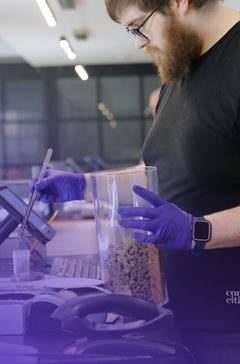-
Standard operating procedures, also known as SOPs, help create efficiencies, maintain compliance, promote transparency, and mitigate risk within your cannabis dispensary.
Simply put, SOPs are detailed, written explanations of how everything should be done, or what process needs to be followed to accurately complete a task. Create an SOP resource for every task that staff completes in your store.
-
Having detailed policies and procedures is considered a necessity to long-term success in most industries, but it’s especially important in cannabis, where compliance is top priority. Some other benefits of dispensary SOPs include:
- Standardize process. Taking the time to identify, document, and communicate SOPs gives peace of mind that your business will be run correctly and consistently, regardless of who's working. Well-executed SOPs standardize processes so that employees know exactly what steps to take to execute tasks successfully and compliantly.
- Create consistency. SOPs standardize the workflow so that every product is handled the same, every customer receives the same experience, and every budtender does their job function the same. SOPs outline how you, as a brand, handle scenarios and make your store more efficient.
- Streamline onboarding/training. SOPs set clear expectations and save time in onboarding and training employees. Rather than relying on staff to pass on process knowledge, every new hire gets consistent, standardized information.
- Aid in compliance. In a heavily regulated industry, standardizing task procedures helps you stay compliant. SOPs help control risk, which would prove invaluable if you were audited or reviewed by your local regulatory agency.
- Empower staff. SOPs empower staff; if they know the how and why of every process in your store, they can not only do their jobs more efficiently, but can make educated decisions in your absence.
- Increase efficiency. SOPs help you operate more efficiently and reduce employee errors, redundancy, fraud, and waste, thus saving you time and increasing profitability. If you’re looking to expand your business, having documented SOPs makes it easier to scale.
-
Creating SOPs seems difficult, but you already have them — maybe they are just not documented. The first step is understanding how you do things at your store. Then consider how you should be doing them. If there are tasks that everyone does differently, decide which way will be the standard.
To identify what SOPs you need and where there's overlap, think of all processes or tasks as having a start and stop point. All steps in the SOP must happen in that stated timeframe.
Rely on staff (the people who actually do the tasks) to help create SOPs. They know how things are actually done, and how they should be done. Enlist their help in writing down the steps. Once written, run the SOPs by employees in different roles to make sure they're complete and easy to follow.
Once the SOP documents are created, it’s imperative that you communicate and enforce them. Every employee must follow every SOP every time. It’s common for processes to start to break down, or for some employees to take shortcuts, but there’s no space for that in cannabis.
Store SOPs in a safe place where all employees can access them, and develop a regular review process to update them as operations change.
Get a jump start by downloading our dispensary SOP templates today!
-
It’s best if your SOPs aren't complicated so that people will use them. Use a basic structure, use simple language, and focus on making SOPs practical.
Every SOP should include:
- Title: The name of the task or process you’re documenting. For example: "inventory intake" or "opening procedures."
- Role: Who is expected to complete the process, by job title. There may be more than one role involved in a task. For example, to close a drawer, the budtender starts the process and the manager reviews/validates and completes the remaining cash handling steps.
- Timing: When is the task completed? Daily? Weekly? Every Tuesday? Every day before opening? As a result of another action, like products arriving? Be as clear as possible about who is responsible for the tasks and when.
- Purpose: Why you need to do this task. Keep it short, but give enough information so staff will understand the reason and risks. For example: "opening procedures" ensure the store is ready for customers, product is secure and stocked, drawers are counted, and all surfaces are clean and sanitized to ensure a successful sales day and a safe experience for patients/customers.
- Steps: The detailed, step-by-step breakdown of how to do the task or process, including who does it. Don't skip steps, don't give partial information, and don’t leave anything to interpretation. If employees have freedom within SOPs to create their own process, you’ve defeated the purpose. Some SOPs will have steps that must be followed in a specific order, and others will have a list of items that can happen in any order. Be sure to clearly outline which is which (we suggest a numbered list for ordered, and bullets for unordered lists).
- Necessary equipment: Whether it’s a specific computer or safety equipment, spell out what equipment or tools the person will need to complete the procedure.
- Other information: Depending on the SOP, there may be other things to note. For example, for "closing procedures," brainstorm all possible alternatives to the norm and spell out how to handle them. Maybe someone is in the store past closing time, list how to get them to leave. Maybe the lock is broken or the key is missing, how do you get the front door secured? If you think through all the worst case scenarios, it’s easier to handle them if they arise.
- Definitions: If any tasks have industry terms or acronyms, especially if they're unique to your brand/store, define them. Anyone should be able to pick up this procedure and complete the task, even without any experience or industry knowledge.
- Date: Note when the procedure was written or last updated. This will help you keep track of old versions and draw attention to old procedures that need to be revisited and updated. (We suggest putting the version and date in the footer).
-
Ideally, yes. Taking the time to document SOPs for every task will help keep your business compliant and efficient. If you’re just getting started, focus on high-priority tasks first — usually those with risk or that are consistently done differently and need to be standardized — like auditing or inventory intake.
Note that some SOPs will have overlapping tasks, but the goal is to have a separate SOP for every function or activity. For example, the "closing procedure" will have steps for closing drawers and reconciling transitions, but you will probably also have an SOP specifically for drawers and cash processes. You may also have separate SOPs by role, so opening for a manager will look different than opening for a receptionist, though both cover the same time frame.
Common dispensary SOPs:
- Inventory intake, packaging, and labeling
- Auditing
- Inventory control, including product storage, rotation, and expiration
- Cash handling, including drawer management, and reconciliation
- Opening and closing process
- Check in
- Check out, specials/discounts, and carts
- Employee management
- Security, health, safety, and emergency protocols
- Accounting and tax procedures
Dispensary Standard Operating Procedures (SOP) Templates
Now that you understand the basics of standard operating procedures for legal cannabis dispensaries, let's get started!
Download the full kit, including inventory intake, auditing, inventory control, cash handling, check in, opening, closing, check out, safety & security, employee management, delivery/order ahead, and power/tech outage. Simply make a copy, edit with your store-specific details,
share with employees, and viola!
If you'd prefer to access specific SOPs only,
keep scrolling to find the template you need.


...or you’re looking for something specific?
- Title What's Inside? Download
-
Cash Handling Procedures
Opening/closing drawers, daytime drops, giving change, depositing cash, and more.
Download -
Check In Procedures
ID/med card verification, waiting room protocol, queue management, and more.
Download -
Check Out Procedures
The check out process – helping customers, adding products, and fulfilling orders.
Download -
Closing Procedures
Nightly cleaning, secure storage, counting drawers, seeing customers out, and more.
Download -
Delivery Procedures
Online orders, fulfillment, and delivery.
Download -
Employee Management Proc.
Employee management – recruiting, hiring, training, scheduling, firing, and more.
Download -
Inventory Audit Procedures
The ideal audit workflow, when to audit, and how to handle discrepancies.
Download -
Inventory Control Procedures
How to store, rotate, move, destroy and order new cannabis products.
Download -
Inventory Intake Procedures
This SOP outlines what happens when new products come into your dispensary.
Download -
Opening Procedures
Unlocking and entering the building, stocking products, preparing drawers, and more.
Download -
Order Ahead Procedures
Online ordering, fulfillment, and checkout.
Download -
Outage Procedures
How to keep transacting – use of hotspots, processing sales manually, and more.
Download -
Safety Procedures
Security, cash/product handling, cleaning, permissions, and incident management.
Download